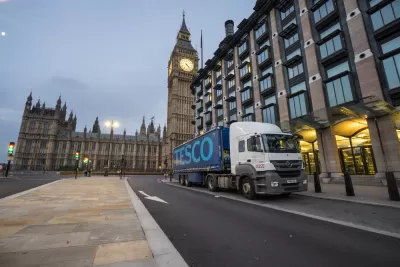The goods movement industry wants a seat at the table.

By Karl Vilacoba
A delivery man pulled and pushed for min-utes on end but couldn’t get his hand truck over the extra high curb. Upon one last try, the frustrated worker’s shipment—a heavy keg of beer—tipped over and rolled into the downtown Washington, D.C., roadway.
At a restaurant across the street, Tom Madrecki watched the episode unfold and considered all of the potential ramifications—safety issues, damaged goods, traffic holdups—which could have been avoided if the curb were a few inches shorter.
American planners spend countless hours mulling how to solve the last-mile question in their cities. But Madrecki’s employer, the world’s largest shipping company, the United Parcel Service (UPS), is concerned above all with the last 50 feet.
“It’s that last 50 feet of the trip where so much can happen, and a lot of things taking place on the city’s side are impacting UPS,” Madrecki, a spokesman for the company, said.
The goal of complete streets policies and improvements is to make streets accessible for all users. In practice, it usually means making car-oriented roads safer for bicyclists and pedestrians. However, complete streets design changes — such as narrower roads and bike lanes—are often the exact opposite of what makes life easier for a truck driver.
Opposing market forces are making the conflicts more pronounced. On one hand, real estate trends nationwide have swung in favor of living spaces in urban cores or downtown areas where residents can walk to stores, restaurants and nightlife. At the same time, the e-commerce revolution has put retail spaces out of business and brought about a surge in deliveries to dense neighborhoods that was never planned for.
How big? According to Alison Conway, a freight policy and logistics expert with the Department of Civil Engineering at the City College of New York, recent research in Fort Lee, New Jersey, found that each residence received about 1.5 packages per week. That means the town’s high-rise apartment buildings overlooking the Manhattan skyline can generate in the neighborhood of 2,000-3,000 deliveries per week.
That said, goods movement experts from around the country say that freight and complete streets are more than compatible. They offered the following food for thought for planners and policymakers as they craft complete streets policies and gear up for road improvement projects.
FULL STORY: Factoring Freight into Complete Streets Plans

Maui's Vacation Rental Debate Turns Ugly
Verbal attacks, misinformation campaigns and fistfights plague a high-stakes debate to convert thousands of vacation rentals into long-term housing.

Planetizen Federal Action Tracker
A weekly monitor of how Trump’s orders and actions are impacting planners and planning in America.

San Francisco Suspends Traffic Calming Amidst Record Deaths
Citing “a challenging fiscal landscape,” the city will cease the program on the heels of 42 traffic deaths, including 24 pedestrians.

Bend, Oregon Zoning Reforms Prioritize Small-Scale Housing
The city altered its zoning code to allow multi-family housing and eliminated parking mandates citywide.

Amtrak Cutting Jobs, Funding to High-Speed Rail
The agency plans to cut 10 percent of its workforce and has confirmed it will not fund new high-speed rail projects.

LA Denies Basic Services to Unhoused Residents
The city has repeatedly failed to respond to requests for trash pickup at encampment sites, and eliminated a program that provided mobile showers and toilets.
Urban Design for Planners 1: Software Tools
This six-course series explores essential urban design concepts using open source software and equips planners with the tools they need to participate fully in the urban design process.
Planning for Universal Design
Learn the tools for implementing Universal Design in planning regulations.
planning NEXT
Appalachian Highlands Housing Partners
Mpact (founded as Rail~Volution)
City of Camden Redevelopment Agency
City of Astoria
City of Portland
City of Laramie





























